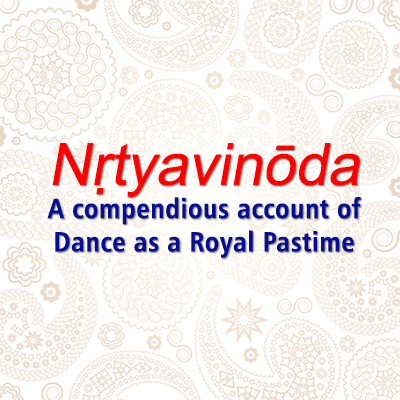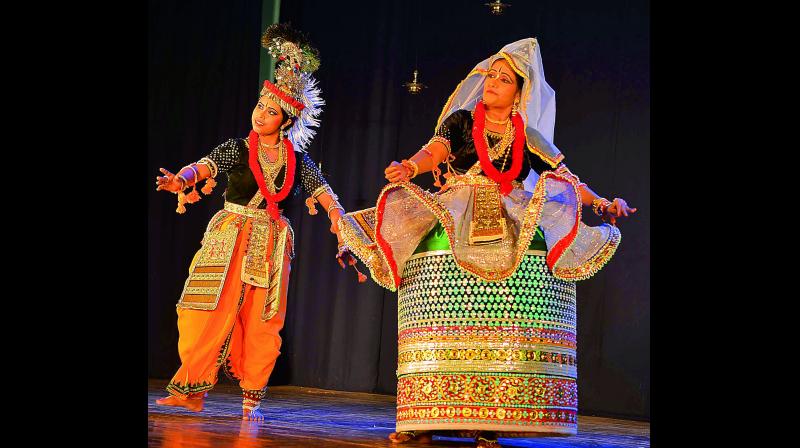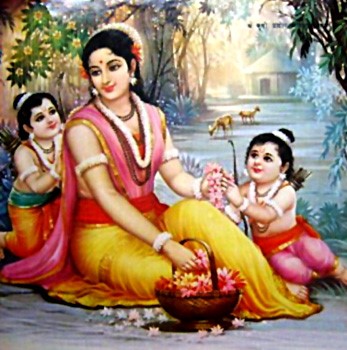– Sarada Nori MA Kuchipudi UofSA
The encyclopedic work Mānasōllāsa, also known as Abhilāśitārthacintāmaṇi, written by the Chālukyan King Bhūlōkamalla Sōmēśvara III of the 12 century AD has given great insights into the royal pastimes of the Western Chālukyas. The literal meaning of the word Mānasōllāsa is ‘delight of the mind’ while Abhilāśitārthacintāmaṇi means ‘Jewel which yields all Dēśīres’. . Sōmēśvara was conferred the title ‘Sarvagnya cakravarti’ in appreciation of his scholarly work pertaining to diverse fields. This compendious text contains 100 chapters clustered into five Vimśatis of twenty Adhyāyas each dealing with multitudinous subjects such as politics, astrology, architecture, painting, music, dancing, poetics, logic, veterinary science, alchemy, gemology, textiles, indoor and outdoor games. Amongst these, the Nṛtyavinōda Adhyāya, which is the 18th Adhyaya of the 4th Vimśati, deals with dance. This article presents a bird’s eye view of Nṛtyavinōda, that deals with dance as a royal pastime. The article draws upon research and publications of Dr. Hema Govindarajan, Dr. Rita Samaddar, Dr. Mandakranta Bose and Dr. Usha Srinivasan. The author, Sōmēśvara, sets himself apart from the others by exemplifying the purpose of dance as a royal pastime. The importance of Nṛtyavinōda of Mānasōllāsa has been recognized by eminent scholars such as Sri Ramakrishna Kavi and Dr. V. Raghavan, before it was published. In his book Bharatakōsa Sri Ramakrishnakavi included an index of terms relating to dance, drama, vocal, instrumental music and prosody with definitions given by various authors. It is significant to note that for about one hundred terms, the definitions given by Sōmēśvara have been included. Dr. V. Raghavan’s edition of the Nṛttaratnāvalī highlights Sōmēśvara’s work. The author of this text Jāya Senāpati acknowledges Sōmēśvara’s proficiency in both Mārgi and Dēśī traditions in several verses. Nṛtyavinōda had been an important source of reference for medieval scholars Sārñgadēva, Pārsvadēva and Basava Bhūpala who belonged to the later generation. Though, all these writers have based their works primarily on Nāṭyaśāstra of Bharata, it is Sōmēśvara’s Nṛtyavinōda which has provided the basis for post-Bharata innovations. The Nṛtyavinōda ‘s contribution to the academics of dance is invaluable as it contains a discussion on a tradition which evolved differently as a non – Nāṭyaśāstra tradition in the medieval time period. It contains 457 verses mainly dealing with Āṅgikābhinaya . Description of Āṅgikābhinaya in Nṛtyavinōda is mostly in line with Nāṭyaśāstra. The text was a precursor to Sārñgadēva’s Sangītaratnākara dated mid thirteenth century A.D. Both Mānasōllāsa and Sangitaratnaka were written in the Karnataka region which remained outside the influence of the Muslims for a long time. As a result, the emerging new traditions could continue and develop, reflecting the inherent cultural practices. The seeds of Dēśī or regional tradition crystallized in Nṛtyavinōda, although the subject was dealt with succinctly. In the entire period between the Nāṭyaśāstra and the Mānasōllāsa only one other manual on dancing was written, the Viśṇdharmōttara Purāṇa. Neither this nor Nāṭyaśāstra record or refer to any Dēśī tradition. Similarly, Abhinavagupta is silent about the Dēśī tradition. Sōmēśvara deals with dance as an independent form which indicates the emerging role of dance as a separate form in the medieval times and not an auxiliary to drama as stated in Nāṭyaśāstra. He also carefully assimilates work done by the previous generations, eliminating discontinued practices and including contemporary ones. Popular entertainment amongst urban people and nobility in particular predominantly took place at various gōsṭhis or clubs. Number of gōsṭhis connected with different fields of art were periodically convened in a public hall or at a residence or even at the house of a courtesan. A samgītagōsṭhi, one of the most popular amongst cultural gatherings, was convened by the kings and nobles where a triple symphony of song, instrumental music and dancing took place. Nṛttagōsṭhi also attracted much attention, and there were numerous references to the dance performances in Sōmēśvara’s Mānasōllāsa[1] . The chaptalization commences with general introduction to dance giving information about the types of dance, the types of dancers and the occasions when this art can be performed. Chapter two, three and four present simple movements and usages of the major limbs or Aṅgas, minor limbs or Upāṅgas and Pratyāṅgas. The concluding chapter deals with complex movements, namely Sthānakas, Cāris and Karaṇas. Sōmēśvara begins Nṛtyavinōda listing out the occasions for dance which are at every festive occasion (Utsava), to celebrate conquests (Vijaya), success in competitions (Vivāda), test of skill (Parīkṣa), occasions of joy (Harṣa), passion (Kāma), merriment (Vilāsa) and sacrifices (Tyāga). Bharata does not discuss anything about the occasions of dance in Nāṭyaśāstra. Six types of performers are described which include danseuse(Nartaki: One who is beautiful, slim, charming, well endowed , skilled in art and good at heart), actor(Naṭa: One who is well versed with languages, expert in evoking bhava and rasa), dancer(Nartaka One who is well versed with foot and hand movements.), bard (Vaitālika :One who is an expert in languages, evokes laughter, mock at and express criticism), wandering performer(Cāraṇa: One who is well versed in the art of playing bells, expert in rendering songs, capable of speaking humorously) and acrobat(Kōlātika : One who is skilled in handling knives, move and turn swiftly, swift jumps, carry weights). Mānasōllāsa gives an account of six types of dances: Narṭana (A form that expresses rasa through caturvidhabinaya [2]), Nāṭya (mimetic), Lāsya(delicate), Tānḍava(vigorous), Visama(acrobatic), Vikaṭa(ludicrous) and Lāghava (light and graceful). Lāsya is filled with graceful Aṅgahāras without foot movements and Karaṇas. Tānḍava is forceful and there is absence of grace. Lāghava, which has Sātvika and Aṅcita Karaṇas, evokes feelings of joy. Viṣama includes foot movements, poses, twirls, movement of limbs while Vikaṭa includes contortions of the face, hands, eyes along with awkward dancing. The categorization of the terms Lāghava, Viśama and Vikaṭa in this context do not appear in earlier texts. They seem to have been regional styles of dancing which were first included by Sōmēśvara under the category of Nartana. The Kannada words ‘Lāga’ and ‘vagaḍa’ frequently appear in Kannada works and appear to be synonymous to Lāghava and Vikaṭa respectively. The Visama is known to be an integral feature of the Pēraṇi [3] dance, a Dēśī tradition that the author discusses. The author states that acrobatic and comical varieties of dancing should be avoided by the king since they cannot generate Śṛngāra rasa or the erotic sentiment. Dancing is categorized into the Mārga and Dēśī varieties, thus reflecting the growth of the two traditions. The Mārga variety is elucidated in Nāṭyaśāstra but the later variety in not documented in any other text preceding Mānasōllāsa. The description of the regional tradition differs from the Mārga tradition in two ways: first, by putting its emphasis on the style of presentation rather than on the content of the composition, and second, by concentrating on the use of more acrobatic movements. As for the content, in structuring a dance piece the Dēśī tradition had very little to offer that was new. Its descriptions of the dances include references to music, rhythm, tempo and styles of presentation but no detailed description of individual movements. Mārga and Dēśī cannot, therefore, be judged to be exclusive of one another in terms of their components. They should rather be seen as different stylistic approaches that grew through time into separate traditions of the same basic art form. This relationship is clearly seen in the descriptions of the two traditions in the dance manuals of the medieval period. The other important contribution of Sōmēśvara is the introduction of the Dēśī Karaṇas which are eighteen in number and found in no other text. Amongst the many Dēśī forms, Goṇḍali or Gauṇḍali dance is most noteworthy. This form, which is mentioned by later writers like Sārñgadēva, was codified by Sōmēśvara. Jāya Senāpati, in his Nṛttaratnāvalī, discusses this in the VII-chapter verses 161-3. In fact, Dr. V.K. Raghavan opines that Jāya Senāpati was one of the authors who studied Sōmēśvara in great detail. Jāya Senāpati states that once, at Kalyan during Bhūtamātr festival, King Sōmēśvara witnessed a huntress (Bhilli) sing and dance. Captivated by her performance, he organized it into a regular dance sequence which, from then on, came to be known as Goṇḍalīvidhi. The name given was in Maharāstri Prākrt [4] , according to which a huntress is known as ‘Goṇḍali’. Sangītaratnākara describes that this dance has its music in Karnāta mode. Sōmēśvara mentions Karnāta as the language of certain kind of songs or music compositions. Saṅgadēva says that the makeup of the Goṇḍali danseuse is to be in Karnāta style. Mānasōllāsa is the first text with a complete and sustained discussion on dancing which treats Lāsya as a division of dancing. The term Nāṭya includes āharya, vācika, sātvika and āngikābhinaya. The inclusion of Nātya as a form of dancing is a continuation from the Viśṇudharmōttara Purāṇa [5] ‘s division of dancing. The use of the term shows that it obviously had a wider meaning at this time than in later times. The term Nṛtya is described as the whole art of dance involving all the major and minor limbs. Throughout this work the author uses Nṛtya as a generic term for dancing. It was first recognized as a distinct category of performance in the Dasarūpaka, a 10th Century C. E text by Dhananjaya. A different classification of Aṅga, Upāṅga and Pratyāṅga is given in Nṛtyavinōda. This includes interchanging of limbs given by Bharata within these three categories. Besides this, additional limbs such as shoulders, wrists, knees, teeth and tongue have been included. The division of the minor limbs into two categories, Upāṅga and Pratyāṅga, is a new approach. Nāṭyaśāstra divides the body into major and minor limbs and the term Bharata uses for the minor limbs is Upāṅga. This division is followed by Viśṇudharmōttara Purāṇa. But Sōmēśvara introduces the subdivision of Pratyāṅgas. The movements of six aṅgas (Head, Shoulders, Hips, Chest, Sides, Belly), eight Upāṅgas (Eyes, Eyebrows, Nose, Cheeks, Lips, Chin, Teeth, Tongue) and six Pratyaṅgas (Arms, Wrists, Palms, Knees, Shanks and Feet) are delineated with the meaning and application. The chin and teeth movements are considered as new additions and innovative. Unlike other texts Sōmēśvara gives the exact positions of certain hand gestures such as Ardhacandra, Mṛgasīrśa and Padmakōsa. The one type of movement to which meaning is not attributed is the nṛttahasta, because these movements are meant for adding beauty, not meaning. Movements of the eyeballs, eyelids, mouth, neck and thighs which have been explained in Nāṭyaśāstra are absent in Nṛtyavinōda. The Twenty-one Dēśī Sthānakas or poses, twenty-six Dēśī earthly Cāris or feet movements, sixteen Dēśī aerial Cāris or feet movements and eighteen Utpluti Karaṇas or movements involving jumps are totally divergent. None of which is found in earlier works. In conclusion, it is clear that Nṛtyavinōda has recorded techniques that developed locally and different from that delineated in Nāṭyaśāstra. The scope of this treatise is basically a handbook on Āṅgikābhinaya. Complex units in connection to the lower body have been recorded which later came to be known as Dēśī. Sōmēśvara inspired the later writers to elaborate on such aspects which is evident from the treatises. References
- Raghavan, V.K. (1965), Nṛttaratnāvalī of Jāya Senāpati, Madras, Sri Ramachandra Printing works
- Hema Govindarajan, (2001), The Nṛtyavinōda of Mānasōllāsa- A Study, New Delhi, Harman Publishing House
- Usha Venkatraman an Srinivasan, (1985), A critical Study of Nṛtyavinōda of Mānasōllāsa: A Thesis submitted for the degree of Doctor of Philosophy in Dance, The Maharaja Sayajirao University of Baroda
- Ramakrishna Kavi, M, (1999), Bharata Kosa, T.T.D Religious Publications Series No.230
- Rita Samaddar, (2000), A Critical Study of the Abhilāśitārthacintāmaṇi By Sōmēśvara: Dissertation submitted for Ph.D. degree in Sanskrit, University of Calcutta
- Joshi, Mahadev Narayanrao ,2003, Arts and Sciences in Sōmēśvara’s Manasollasa
- Bose, Mandakranta, (2012) Movement and mimesis: The Idea of Dance in the Sanskritic Tradition, Springer Science & Business Media


